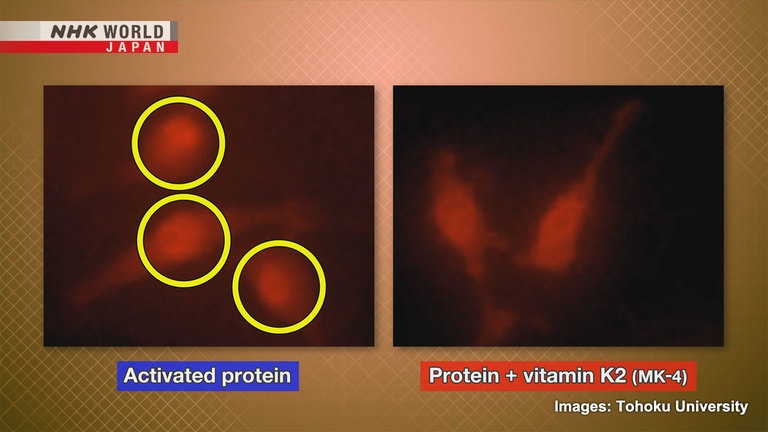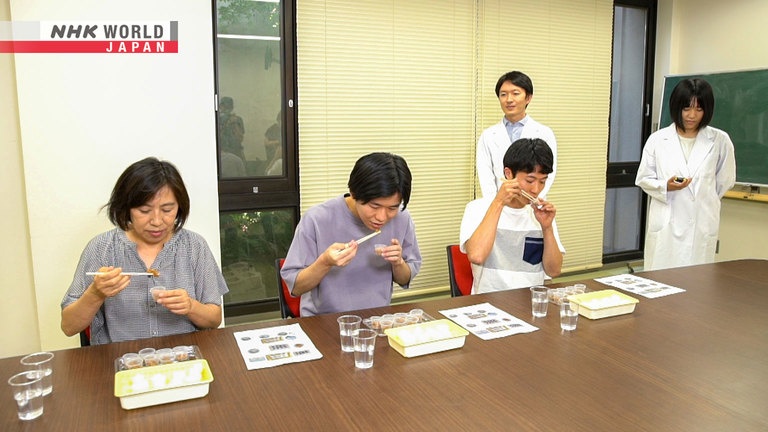The Power of Natto, a Japanese Superfood
Natto is a traditional Japanese fermented food with a unique smell and stickiness. In 2020, the National Cancer Center announced that high consumption of natto lowers mortality risk. Natto not only activates the immune system, but also contains a significant amount of vitamin K2, which can suppress brain inflammation, while the substance responsible for its stickiness lowers blood sugar levels. We report the latest findings on the health benefits of natto, which is drawing attention worldwide.




Transcript
Join us as we explore Medical Frontiers!
These sticky threads are a unique feature of a traditional Japanese food called "natto."
It's packed with nutrients such as protein, dietary fiber, vitamins and minerals.
These fermented soybeans are the focus of today's program.
Through the latest science, we'll delve into this food that helps Japanese people live long and healthy lives.
Have you heard of "natto?"
It's a staple of Japanese breakfasts.
And personally, I have a slight aversion to its distinct unique smell and stickiness.
However, it's surprising just how many health benefits this food offers.
Recent studies have revealed its potential in curbing blood sugar spikes after meals
and even lowering the risk of mortality from certain diseases.
So let's uncover the secrets behind the powers of natto, Japan's superfood.
In 2020, Japan's National Cancer Center announced the results of a study
that showed the association between mortality risk and the intake of fermented soy products,
specifically natto and miso soybean paste.
The study followed about 90,000 participants for an average of 15 years.
It found that both men and women who ate around 50 grams of fermented soy products a day
had a roughly 10 percent lower mortality risk than those who consumed less than that.
What's more, the study also showed that a higher intake of natto
is associated with a lower mortality risk from heart conditions and other cardiovascular diseases.
One of the places included in the study was Yokote City in Akita Prefecture, northeastern Japan.
Consumption of natto is high in this area.
As it has long been part of the local food culture.
Let's look at how natto is included in daily meals.
Hello.
Hi there.
Fukuda Setsuko, who runs a farm, welcomed us into her home.
Mealtimes are lively, with four generations of the family,
from a four-year-old to those in their 30s, 60s and 80s.
Natto usually comes in containers of about 50 grams each and is sold in 3 packs for less than a dollar.
It should be stirred well before eating until it forms fine threads and a fluffy texture.
Natto has a strong smell.
So, the most common way to eat it is to season it with soy sauce and pour it over a bowl of hot rice.
How's the natto?
It's delicious.
Our children love natto.
Natto makes them eat more rice.
They even ask for natto for dinner.
Eating natto is a routine part of our lives.
We always have some in the fridge.
-Can I have some natto miso soup?
-Sure!
Natto miso soup is a local specialty.
It helps to guard against the region's severe winter weather.
When natto is mashed to a paste and simmered with ingredients such as finely chopped mushrooms,
mountain vegetables and taro, it becomes a thick soup that warms the body from the inside.
It's also a staple of certain occasions, such as New Year's, weddings and funerals.
It can be added to stir-fries or sandwiched between fish cakes and grilled with cheese on top.
It's versatile and adds color to the dining table.
Teiichi, the oldest member of the family, says he has lived 88 years without any serious diseases.
-Injuries only?
-I've broken legs.
You recover fast, thanks to natto.
You're probably right.
Natto and tofu are healthy. I don't know
the details, but that's why I eat them.
People of all ages and genders love natto, a food that supports daily life and health.
Let's explore how it's made.
The ingredients are simple: soybeans and a microbe called Bacillus subtilis natto.
There's a deposit at the bottom.
They're lumps of natto bacillus.
This is a microscopic image of natto bacillus.
This microbe can ferment soybeans and turn them into natto.
To make natto, soybeans are soaked in water for about 15 hours,
steamed rapidly in a pressure cooker, then sprayed with natto bacillus while they're hot.
The hot beans are packed in containers right away to prevent the growth of bacteria other than natto bacillus.
After fermenting overnight in a room maintained at around 40 degrees Celsius,
they are cooled and allowed to mature for several days until the natto is ready.
This footage shows the fermentation of soybeans by natto bacillus.
It can break down the soybeans' nutrients and create new substances.
The unique smell and stickiness of natto develop during this process.
Our first keyword today is natto bacillus and immunity.
To learn about the health benefits of natto,
we spoke with food-immunology specialist Tsuji Noriko.
Natto bacillus is robust and multiplies quickly.
It can withstand stomach acid and reaches the intestines active.
How does natto and bacillus subtilis natto, what do they specifically do in the body?
Bacillus subtilis natto activates innate immunity.
Innate immunity is a mechanism that immediately detects and attacks pathogens
and other foreign substances when they enter the body.
The key is the small intestine, where many immune cells are located.
Natto bacillus flips the switch that activates innate immunity.
This footage shows that process.
Natto bacillus is interacting directly with the cells inside a mouse's small intestine.
Red spots start to appear.
Their growing number indicates that natto bacillus is activating innate immunity.
What's more, the abundant dietary fiber in natto serves as nourishment for countless intestinal bacteria,
which are crucial in maintaining and improving immune function.
Natto bacillus doesn't live in the gut and may
be new to the cells on the intestinal surface.
Therefore, it may have a more activating
effect than bacteria that reside there.
But it's still unknown why that is.
The white coating on the natto is a layer of natto bacillus.
The recommended daily intake of natto is one pack, or about 50 grams, containing about 500 billion natto bacilli.
Natto bacillus activates immunity, leading to
benefits such as prevention of
infections, allergies and other diseases.
But I doubt natto bacillus will
take root in the intestines.
It provides the benefits as it
passes through the body.
That's why it's important to eat natto regularly.
Natto is said to have originated over 1,000 years ago.
Natto bacillus is commonly found in rice straw.
Back then, people would wrap boiled soybeans in the straw to ferment them.
Natto became popular among ordinary Japanese people about 400 years ago.
Vendors would walk through the streets every morning, selling natto.
A Japanese food encyclopedia that dates back as far as the latter half of the 1600s says
"natto has intestinal regulation and detoxification effects."
Over the centuries, natto has supported the diet and health of the Japanese people.
Food culture isn't just about what's delicious.
It's about choosing things that are
beneficial for our health and gut bacteria,
and avoiding harmful substances.
I think food culture is a part of human evolution.
Among the various health benefits of natto, one that is gaining significant attention is the power of vitamin K2.
This is our second keyword.
Shirakawa Hitoshi, a scientist in northeastern Japan, has been studying this vitamin.
To uncover its secrets, he uses nutritional chemistry.
Vitamin K2, a type of vitamin K that occurs naturally, is contained in fermented foods, such as natto, and in animal products.
Along with K1, which is abundant in greens, vitamin K2 has been known since ancient times as a nutrient
that helps with blood coagulation and bone formation.
Since it cannot be made by the human body, it must be obtained from external sources.
Natto is rich in vitamin K2.
Among the foods that can be eaten
in manageable amounts,
natto is probably the best source of vitamin K.
The recommended daily intake of vitamin K is 150 micrograms.
One pack of natto contains about three times that amount.
Shirakawa believes vitamin K2 has many undiscovered health benefits
and has been conducting research to uncover them.
He came to this conclusion after he and his team examined rats
and found that much of the vitamin K they consumed was converted into a type of vitamin K2 called menaquinone-4, or MK-4.
It then accumulated in various organs, including the brain and testes.
We found that vitamin K2 helps to generate
more testosterone, the male hormone.
Testosterone is a male hormone produced mainly in the testes.
It is responsible for sexual health, muscle enhancement and increased energy.
Its secretion decreases with age and stress.
Shirakawa compared the changes in testosterone levels of rats fed a normal diet
and rats fed a diet with added vitamin K2.
After 5 weeks, the rats given a diet rich in vitamin K2 showed an increase in testosterone levels.
When testosterone falls below a certain
level, motivation starts to drop.
Muscle mass also decreases.
I believe eating foods containing vitamin K2
will curb or prevent such symptoms.
Shirakawa is also studying the relationship between brain inflammation and vitamin K2.
This image shows a type of protein, stained in red,
that's related to the production of inflammatory substances in mice's brain cells.
When this protein becomes active, it triggers brain inflammation,
which is thought to be linked to the development and progression of Alzheimer's disease and other brain disorders.
Normally, this protein stays outside the cell nucleus.
But under stress or other triggers, it is activated and enters the nucleus,
where it produces substances that cause inflammation.
This image shows the protein deliberately activated for an experiment, gathering in certain spots and forming circles.
These spots shown in blue are the nuclei of the cells,
where the activated protein gathers as the previous image shows.
However, when vitamin K2 is added, the movement of the protein to the nuclei almost ceases.
The nuclei are not as round as those in the image of the activated protein.
Shirakawa believes vitamin K2 stops activation of the protein
and its entry into the nuclei, thereby suppressing inflammation.
Aging triggers inflammation in many
parts of the body, including the brain.
Proper intake of vitamin K2
can control inflammation.
I believe it may lower the risk of diseases
associated with chronic inflammation.
I think vitamin K2 is key to extending
people's health spans.
Another scientist has found that natto's signature stickiness
has the power to lower blood sugar levels after meals.
Hashimoto Koichi made this discovery during his studies on how food can prevent diseases.
Our third keyword is "gamma-polyglutamic acid," or "gamma-PGA,"
the component responsible for the stickiness.
Until now, there wasn't much research on γ-PGA.
But there were reports on β-glucan,
a similar substance contained in barley.
The reports said eating β-glucan-rich foods
can control post-meal blood-sugar levels.
I began this study thinking γ-PGA
might have a similar effect.
Hashimoto took part in research commissioned by the Japanese Ministry of Agriculture.
In an experiment, 36 participants were divided into two groups.
One group ate natto low in gamma-PGA,
while the other had natto with almost eight times as much gamma-PGA.
Both groups also had rice.
Blood sugar levels were measured before and after eating.
Please start.
Each participant was given eight portions of natto and rice.
They had one minute to eat each portion.
To obtain accurate data, the participants had to eat the natto first,
then put the rice in the empty container to scoop up all the sticky residue.
To further improve the data's accuracy, the experiment was conducted again four or more days later,
switching the types of natto the two groups ate.
This graph shows changes in the participants' blood sugar levels.
When they ate only rice or rice with natto low in gamma-PGA, their blood sugar increased over time.
But when they had natto high in gamma-PGA,
the rise in blood sugar 30 minutes later was significantly reduced compared with when they ate natto low in gamma-PGA,
and this effect continued even after 45 minutes.
Hashimoto and his team suspect that gamma-PGA, the sticky substance in natto,
suppressed sugar absorption in the small intestine.
Controlling the rise in blood sugar within one hour after eating
is thought to help prevent and help diabetes symptoms.
I was really happy with the result.
It's important to prevent diseases
through diet and lifestyle habits.
I want to conduct more clinical trials to prove
that natto and Japanese food are healthy,
and share that evidence worldwide.
While Natto has numerous health benefits.
We asked Tsuji whether there are any disadvantages to eating it.
Over time, people have learned
the right amount of natto to eat,
maintaining a balanced symbiotic
relationship with their gut bacteria.
As long as you eat natto as
part of a balanced diet,
you can safely enjoy your meals
and stay healthy at the same time.
If you have a soy allergy or are taking blood-thinning medication,
caution is advised as the vitamin K2 in natto may affect blood coagulation.
I think some people are going to be so inspired to try natto.
To better enjoy your meals, it's beneficial
to include a variety of fermented foods.
They're not only good for your immune
system, but also beneficial for gut health.
For those who haven't had natto before,
I recommend trying it out.
Thank you so much.
For me, I'm inspired to even eat more natto.
Thank you so much.
Thank you.
Today, Tominaga Noriko, an instructor of Japanese cuisine,
will share some simple natto recipes that you can try,
even if you're new to natto or not so fond of it.
Tominaga offers cooking lessons to introduce Japanese food to people from different cultures.
Do you like natto?
No! hahaha!
I know how healthy it is.
And I recommend it all the time.
But personally and it's not something that I would think yum! it's delicious.
So today I'm really looking forward to learning some recipes.
Healthy benefit and a taste benefit of as well.
-I think that's the key thing.
-All right.
The first dish is miso soup with natto.
Chop the natto into small pieces.
Why we have to chop the natto because "nebaneba" texture comes out,
it's more delicious taste.
Prepare a pot of dashi stock with dissolved miso and add the chopped natto and diced tofu.
Natto bacillus is relatively heat-resistant, but avoid overcooking it.
From here I can't smell it.
So I'm going to smell up close.
Yeah. I can still smell a little bit of natto but it's not as strong as usual.
Yeah. That's exactly.
So I'm going to have a taste.
"Itadakimasu."
-It's wonderful!
-Thank you so much.
It's delicious.
The interesting thing is I cannot taste the natto.
Miso, a fermented food also made from soybeans,
helps to soften the distinct taste and smell of natto, making it much easier to eat.
This is great. I think everyone will enjoy this recipe.
Absolutely.
The second dish is rolled natto omelet.
Add sugar or other seasonings and a bit of water to some eggs, and beat them well.
Heat some oil in a frying pan over medium heat.
Pour in a quarter of the egg mixture.
When the eggs are half-cooked, add chopped natto and roll it up.
Add more egg mixture and roll it up again.
Repeat this a few times, and it's ready.
Uh, the actually the egg.
I kind of conceals a little bit of the smell of the natto, and I see as quite delicious.
Enclosing the natto in the sweet eggs makes it more appealing to those who aren't fond of its smell.
Natto is very useful that they can eat it, good combination with many ingredients.
-Can you make a normal omelet with natto?
-Yeah, exactly.
-Or for example scrambled eggs. With natto?
-Scrambled eggs. Yeah.
-And also with the ketchup.
-With ketchup. Wow.
That's that. That'd be interesting combination too.
The third dish is natto toast.
Spread mayonnaise and ketchup on a slice of bread,
then add chopped natto, sliced avocado and cheese, and toast it until it turns golden brown.
The abundant vitamin K2 in natto is fat-soluble.
Eating it with avocado, which is high in fat, allows your body to absorb it easily.
Natto is often sold at Asian supermarkets, so we encourage you to give it a try.
-The recipes were surprisingly delicious.
-Really!?
-Thank you so much.
-Thank you so much. My pleasure.
Thank you very much.
Natto is such an everyday food here in Japan,
and it has been supporting the health and longevity of Japanese people for centuries.
Even before recent research revealed more about amazing health benefits.
And it reminds me of the saying, "Health is wealth."
I very much hope its incredible benefits will continue to be enjoyed not only by people in Japan
but also people all around the world.